weight MERCEDES-BENZ S CLASS 2019 Owners Manual
[x] Cancel search | Manufacturer: MERCEDES-BENZ, Model Year: 2019, Model line: S CLASS, Model: MERCEDES-BENZ S CLASS 2019Pages: 578, PDF Size: 23.31 MB
Page 21 of 578
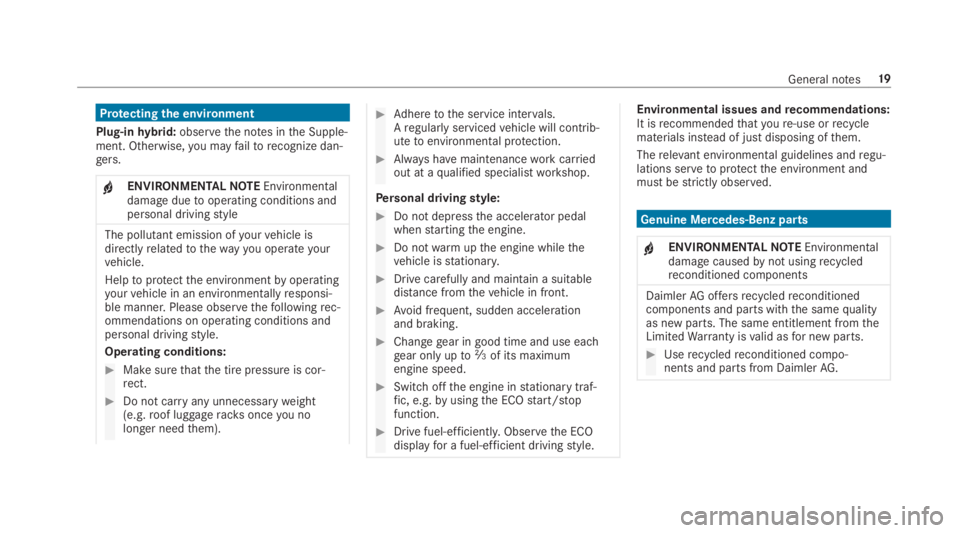
Protectingthe environment
Plug-inhybrid:observethe notes inthe Supple‐ment. Otherwise,you mayfailtorecognize dan‐gers.
+ENVIRONMENTALNOTEEnvironmentaldamageduetooperating conditions andpersonal drivingstyle
The pollutant emission ofyourvehicle isdirectlyrelatedtothewayyou operateyourvehicle.
Helptoprotectthe environmentbyoperatingyourvehicle in an environmentallyresponsi‐ble manner. Please observethefollowingrec‐ommendations on operating conditions andpersonal drivingstyle.
Operating conditions:
#Make surethatthe tire pressure is cor‐rect.
#Do not carryany unnecessaryweight(e.g.roof luggageracks onceyou nolonger needthem).
#Adheretothe service intervals.Aregularly servicedvehicle will contrib‐utetoenvironmental protection.
#Always havemaintenanceworkcarriedout at aqualified specialistworkshop.
Personal drivingstyle:
#Do not depressthe accelerator pedalwhenstartingthe engine.
#Do notwarmupthe engine whilethevehicle isstationary.
#Drive carefully and maintain a suitabledistance fromthevehicle in front.
#Avoid frequent, sudden accelerationand braking.
#Changegear in good time and use eachgear onlyupto�
Page 44 of 578
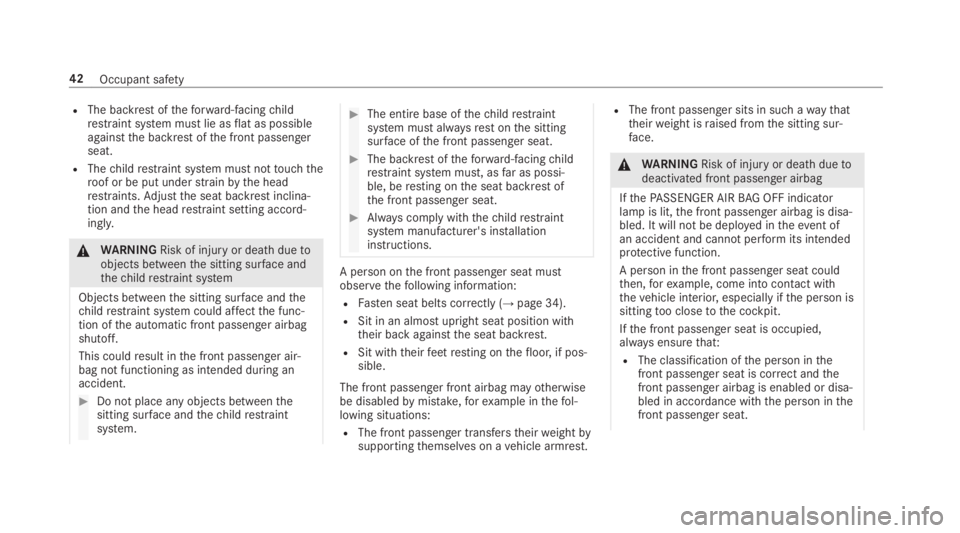
RThe backrest oftheforward-facingchildrestraint system must lie asflat as possibleagainstthe backrest ofthe front passengerseat.
RThechildrestraint system must nottouchtheroof or be put understrainbythe headrestraints.Adjustthe seat backrest inclina‐tion andthe headrestraint setting accord‐ingly.
&WARNINGRisk of injuryor death duetoobjects betweenthe sitting surface andthechildrestraint system
Objects betweenthe sitting surface andthechildrestraint system could affectthe func‐tion ofthe automatic front passenger airbagshutoff.
This couldresult inthe front passenger air‐bag not functioning as intended during anaccident.
#Do not place any objects betweenthesitting surface andthechildrestraintsystem.
#The entire base ofthechildrestraintsystem must alwaysrestonthe sittingsurface ofthe front passenger seat.
#The backrest oftheforward-facingchildrestraint system must, asfar as possi‐ble, beresting onthe seat backrest ofthe front passenger seat.
#Always comply withthechildrestraintsystem manufacturer's installationinstructions.
A person onthe front passenger seat mustobservethefollowing information:
RFasten seat belts correctly (→page34).
RSit in an almost upright seat position withtheir back againstthe seat backrest.
RSit withtheirfeetresting onthefloor, if pos‐sible.
The front passenger front airbag mayotherwisebe disabledbymistake,forexample inthefol‐lowing situations:
RThe front passenger transferstheirweightbysupportingthemselves on avehicle armrest.
RThe front passenger sits in such awaythattheirweight israised fromthe sitting sur‐face.
&WARNINGRisk of injuryor death duetodeactivated front passenger airbag
IfthePASSENGER AIRBAG OFF indicatorlamp is lit,the front passenger airbag is disa‐bled. It will not be deployed intheevent ofan accident and cannotperformits intendedprotective function.
A person inthe front passenger seat couldthen,forexample, come into contact withthevehicle interior, especially ifthe person issittingtoo closetothe cockpit.
Ifthe front passenger seat is occupied,always ensurethat:
RThe classification ofthe person inthefront passenger seat is correct andthefront passenger airbag is enabled or disa‐bled in accordance withthe person inthefront passenger seat.
42Occupant safety
Page 49 of 578
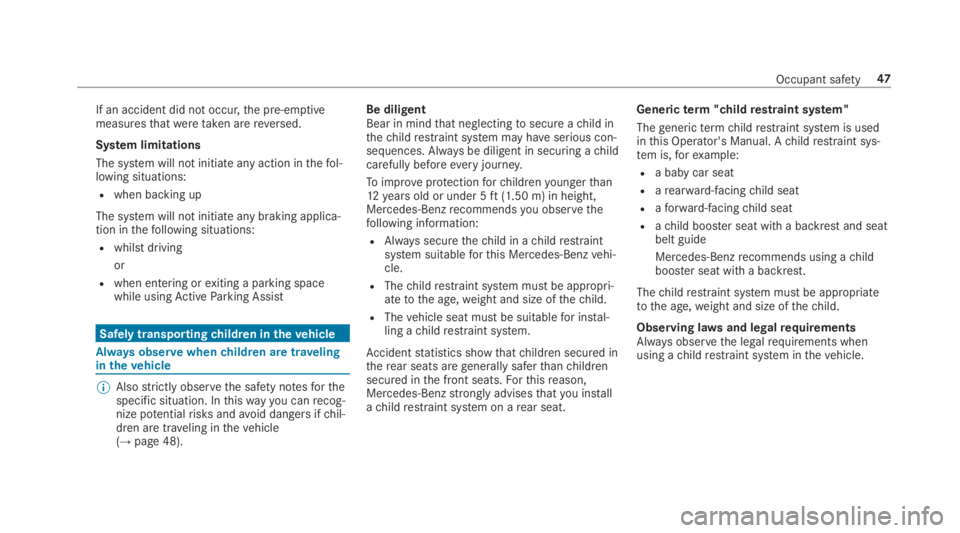
If an accident did not occur,the pre-emptivemeasuresthatweretaken arereversed.
System limitations
The system will not initiate any action inthefol‐lowing situations:
Rwhen backing up
The system will not initiate any braking applica‐tion inthefollowing situations:
Rwhilst driving
or
Rwhen entering orexiting a parking spacewhile usingActiveParking Assist
Safely transportingchildren inthevehicle
Always observewhenchildren are travelinginthevehicle
%Alsostrictly observethe safety notesforthespecific situation. Inthiswayyou canrecog‐nize potentialrisks andavoid dangers ifchil‐dren are traveling inthevehicle(→page 48).
Be diligentBear in mindthat neglectingtosecure achild inthechildrestraint system may haveserious con‐sequences. Always be diligent in securing achildcarefully beforeeveryjourney.
Toimproveprotectionforchildrenyoungerthan12years old or under 5ft(1.50 m) in height,Mercedes-Benzrecommendsyou observethefollowing information:
RAlways securethechild in achildrestraintsystem suitableforthis Mercedes-Benzvehi‐cle.
RThechildrestraint system must be appropri‐atetothe age,weight and size ofthechild.
RThevehicle seat must be suitablefor instal‐ling achildrestraint system.
Accidentstatistics showthatchildren secured intherear seats aregenerally saferthanchildrensecured inthe front seats.Forthisreason,Mercedes-Benzstrongly advisesthatyou installachildrestraint system on arear seat.
Genericterm"childrestraint system"
Thegenerictermchildrestraint system is usedinthis Operator's Manual. Achildrestraint sys‐tem is,forexample:
Ra baby car seat
Rarearward-facingchild seat
Raforward-facingchild seat
Rachild booster seat with a backrest and seatbelt guide
Mercedes-Benzrecommends using achildbooster seat with a backrest.
Thechildrestraint system must be appropriatetothe age,weight and size ofthechild.
Observing lawsand legalrequirementsAlways observethe legalrequirements whenusing achildrestraint system inthevehicle.
Occupant safety47
Page 50 of 578
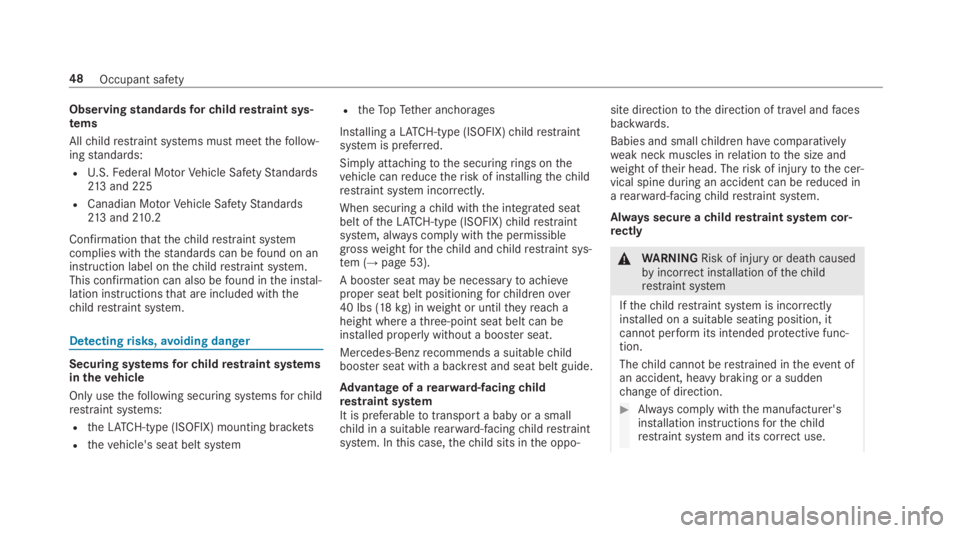
Observingstandardsforchildrestraint sys‐tems
Allchildrestraint systems must meetthefollow‐ingstandards:
RU.S.Federal MotorVehicle SafetyStandards213 and 225
RCanadian MotorVehicle SafetyStandards213 and210.2
Confirmationthatthechildrestraint systemcomplies withthestandards can befound on aninstruction label onthechildrestraint system.This confirmation can also befound inthe instal‐lation instructionsthat are included withthechildrestraint system.
Detectingrisks,avoiding danger
Securing systemsforchildrestraint systemsinthevehicle
Only usethefollowing securing systemsforchildrestraint systems:
RtheLATCH-type (ISOFIX) mounting brackets
Rthevehicle's seat belt system
RtheTopTether anchorages
Installing aLATCH-type (ISOFIX)childrestraintsystem is preferred.
Simply attachingtothe securingrings onthevehicle canreducetherisk of installingthechildrestraint system incorrectly.
When securing achild withthe integrated seatbelt oftheLATCH-type (ISOFIX)childrestraintsystem, always comply withthe permissiblegrossweightforthechild andchildrestraint sys‐tem (→page 53).
A booster seat may be necessarytoachieveproper seat belt positioningforchildrenover40 lbs (18kg) inweight or untiltheyreach aheight where athree-point seat belt can beinstalled properlywithout a booster seat.
Mercedes-Benzrecommends a suitablechildbooster seat with a backrest and seat belt guide.
Advantage of arearward-facingchildrestraint systemIt is preferabletotransporta baby or a smallchild in a suitablerearward-facingchildrestraintsystem. Inthis case,thechild sits inthe oppo‐
site directiontothe direction of travel andfacesbackwards.
Babies and smallchildren havecomparativelyweak neck muscles inrelationtothe size andweight oftheir head. Therisk of injurytothe cer‐vical spine during an accident can bereduced inarearward-facingchildrestraint system.
Always secure achildrestraint system cor‐rectly
&WARNINGRisk of injuryor death causedbyincorrect installation ofthechildrestraint system
Ifthechildrestraint system is incorrectlyinstalled on a suitable seating position, itcannot performits intended protective func‐tion.
Thechild cannot berestrained intheevent ofan accident, heavy braking or a suddenchange of direction.
#Always comply withthe manufacturer'sinstallation instructionsforthechildrestraint system and its correct use.
48Occupant safety
Page 56 of 578
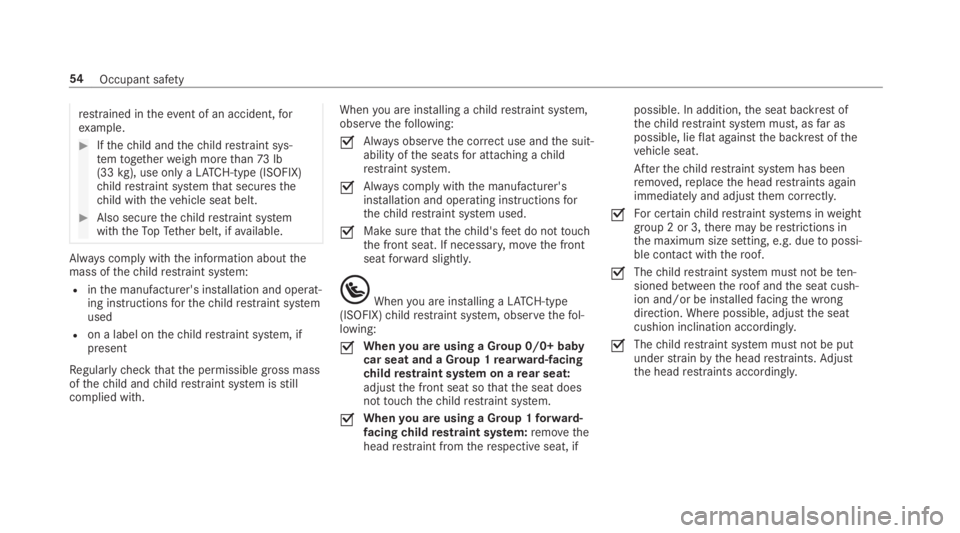
restrained intheevent of an accident,forexample.
#Ifthechild andthechildrestraint sys‐temtogetherweigh morethan73lb(33kg), useonly aLATCH-type (ISOFIX)childrestraint systemthat securesthechild withthevehicle seat belt.
#Also securethechildrestraint systemwiththeTopTether belt, ifavailable.
Always comply withthe information aboutthemass ofthechildrestraint system:
Rinthe manufacturer's installation and operat‐ing instructionsforthechildrestraint systemused
Ron a label onthechildrestraint system, ifpresent
Regularlycheckthatthe permissible gross massofthechild andchildrestraint system isstillcomplied with.
Whenyou are installing achildrestraint system,observethefollowing:
�sAlways observethe correct use andthe suit‐ability ofthe seatsfor attaching achildrestraint system.
�sAlways comply withthe manufacturer'sinstallation and operating instructionsforthechildrestraint system used.
�sMake surethatthechild'sfeetdo nottouchthe front seat. If necessary,movethe frontseatforward slightly.
Whenyou are installing aLATCH-type(ISOFIX)childrestraint system, observethefol‐lowing:
�sWhenyou are using a Group 0/0+ babycar seat and a Group 1rearward-facingchildrestraint system on arear seat:adjustthe front seat sothatthe seat doesnottouchthechildrestraint system.
�sWhenyou are using a Group 1forward-facingchildrestraint system:removetheheadrestraint fromtherespective seat, if
possible. In addition,the seat backrest ofthechildrestraint system must, asfar aspossible, lieflat againstthe backrest ofthevehicle seat.
Afterthechildrestraint system has beenremoved,replacethe headrestraints againimmediately and adjustthem correctly.
�sFor certainchildrestraint systems inweightgroup 2 or 3,there may berestrictions inthe maximum size setting, e.g. duetopossi‐ble contact with theroof.
�sThechildrestraint system must not beten‐sioned betweentheroof andthe seat cush‐ion and/or be installedfacingthe wrongdirection. Where possible, adjustthe seatcushion inclination accordingly.
�sThechildrestraint system must not be putunderstrainbythe headrestraints.Adjustthe headrestraints accordingly.
54Occupant safety
Page 59 of 578
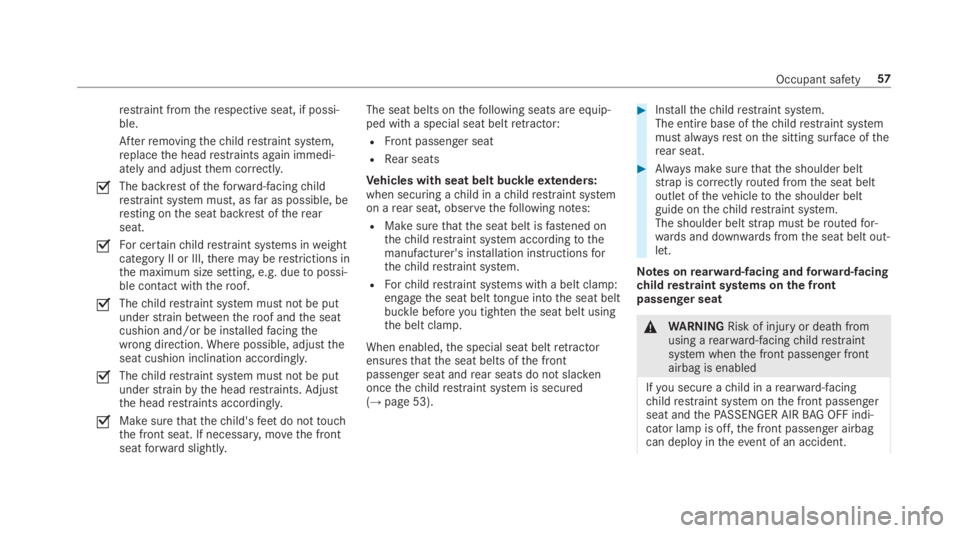
restraint fromtherespective seat, if possi‐ble.
Afterremovingthechildrestraint system,replacethe headrestraints again immedi‐ately and adjustthem correctly.
�sThe backrestoftheforward-facingchildrestraint system must, asfar as possible, beresting onthe seat backrest oftherearseat.
�sFor certainchildrestraint systems inweightcategory II or III,there may berestrictions inthe maximum size setting, e.g. duetopossi‐ble contact with theroof.
�sThechildrestraint system must not be putunderstrain betweentheroof andthe seatcushion and/or be installedfacingthewrong direction. Where possible, adjusttheseat cushion inclination accordingly.
�sThechildrestraint system must not be putunderstrainbythe headrestraints.Adjustthe headrestraints accordingly.
�sMake surethatthechild'sfeetdo nottouchthe front seat. If necessary,movethe frontseatforward slightly.
The seat belts onthefollowing seats are equip‐ped with a special seat beltretractor:
RFront passenger seat
RRear seats
Vehicles with seat belt buckleextenders:when securing achild in achildrestraint systemon arear seat, observethefollowing notes:
RMake surethatthe seat belt isfastened onthechildrestraint system accordingtothemanufacturer's installation instructionsforthechildrestraint system.
RForchildrestraint systems with a belt clamp:engagethe seat belttongue intothe seat beltbuckle beforeyou tightenthe seat belt usingthe belt clamp.
When enabled,the special seat beltretractorensuresthatthe seat belts ofthe frontpassenger seat andrear seats do not slackenoncethechildrestraint system is secured(→page 53).
#Installthechildrestraint system.The entire base ofthechildrestraint systemmust alwaysrestonthe sitting surface oftherear seat.
#Always make surethatthe shoulder beltstrap is correctlyrouted fromthe seat beltoutlet ofthevehicletothe shoulder beltguide onthechildrestraint system.The shoulder beltstrap must beroutedfor‐wards and downwards fromthe seat belt out‐let.
Notes onrearward-facing andforward-facingchildrestraint systems onthe frontpassenger seat
&WARNINGRisk of injuryor death fromusing arearward-facingchildrestraintsystem whenthe front passenger frontairbag is enabled
Ifyou secure achild in arearward-facingchildrestraint system onthe front passengerseat andthePASSENGER AIRBAG OFF indi‐cator lamp is off,the front passenger airbagcan deploy intheevent of an accident.
Occupant safety57
Page 60 of 578
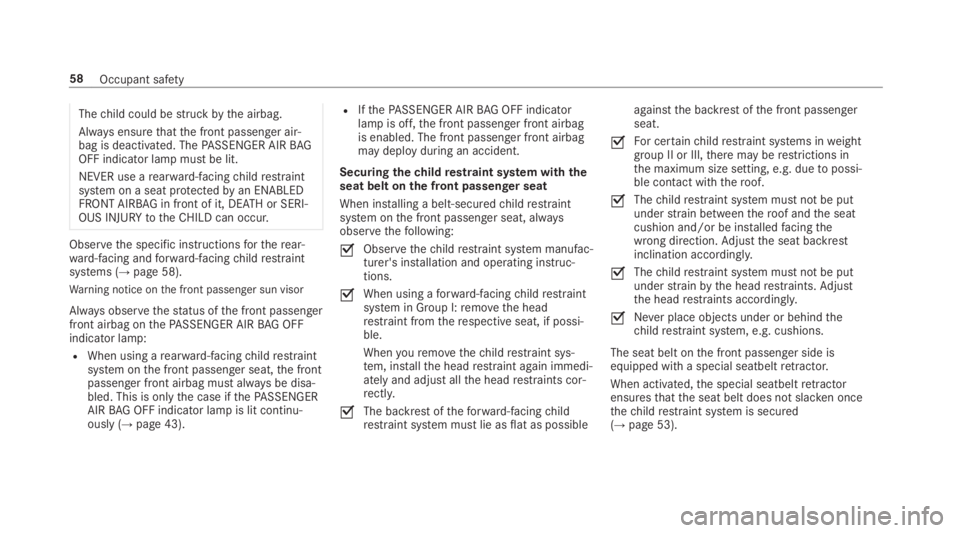
Thechild could bestruckbythe airbag.
Always ensurethatthe front passenger air‐bag is deactivated. ThePASSENGER AIRBAGOFF indicator lamp must be lit.
NEVER use arearward-facingchildrestraintsystem on a seat protectedbyan ENABLEDFRONT AIRBAGin front of it, DEATH or SERI‐OUS INJURYtotheCHILD can occur.
Observethe specific instructionsfortherear‐ward-facing andforward-facingchildrestraintsystems (→page 58).
Warning notice onthe front passenger sun visor
Always observethestatus ofthe front passengerfront airbag onthePASSENGER AIRBAG OFFindicator lamp:
RWhen using arearward-facingchildrestraintsystem onthe front passenger seat,the frontpassenger front airbag must always be disa‐bled. This is onlythe case ifthePASSENGERAIRBAG OFF indicator lamp is lit continu‐ously (→page 43).
RIfthePASSENGER AIRBAG OFF indicatorlamp is off,the front passenger front airbagis enabled. The front passenger front airbagmay deploy during an accident.
Securingthechildrestraint system withtheseat belt onthe front passenger seat
When installing a belt-securedchildrestraintsystem onthe front passenger seat, alwaysobservethefollowing:
�sObservethechildrestraint system manufac‐turer's installation and operating instruc‐tions.
�sWhen using aforward-facingchildrestraintsystem in Group I:removethe headrestraint fromtherespective seat, if possi‐ble.
Whenyouremovethechildrestraint sys‐tem, installthe headrestraint again immedi‐ately and adjust allthe headrestraints cor‐rectly.
�sThe backrest oftheforward-facingchildrestraint system must lie asflat as possible
againstthe backrest ofthe front passengerseat.
�sFor certainchildrestraint systems inweightgroup II or III,there may berestrictions inthe maximum size setting, e.g. duetopossi‐ble contact with theroof.
�sThechildrestraint system must not be putunderstrain betweentheroof andthe seatcushion and/or be installedfacingthewrong direction.Adjustthe seat backrestinclination accordingly.
�sThechildrestraint system must not be putunderstrainbythe headrestraints.Adjustthe headrestraints accordingly.
�sNever place objects under or behindthechildrestraint system, e.g. cushions.
The seat belt onthe front passenger side isequipped with a special seatbeltretractor.
When activated,the special seatbeltretractorensuresthatthe seat belt does not slacken oncethechildrestraint system is secured(→page 53).
58Occupant safety
Page 124 of 578

alwaysrestrainthe objectstheycontain intheevent of an accident.
There is arisk of injury,particularly intheevent of sudden braking or a suddenchangein direction.
#Alwaysstowobjects in such awaythattheycannot betossed about inthese orsimilar situations.
#Always make surethat objects do notproject fromstowage spaces, parcelnets orstowage nets.
#Closethe lockablestowage spacesbeforestarting a journey.
#Alwaysstowand secure objectsthatare heavy, hard, pointed, sharp-edged,fragile ortoo large inthe trunk.
Observethe notes onthe cup holders.
&WARNINGRisk of burning fromthetail‐pipe ortailpipe trim
Thetailpipe andtailpipe trim can becomeveryhot. Ifyou come into contact withthesecar parts,you could burnyourself.
#Always be particularlycareful when inthe vicinity ofthetailpipe andtailpipetrims and supervisechildrenveryclosely when inthis area.
#Before any contact, allowthe car partstocool down.
The drivingcharacteristics ofyourvehicle aredependent onthe distribution ofthe load withinthevehicle.You should bearthefollowing inmind when loadingthevehicle:
Rneverexceedthe permissible gross mass orthe gross axleweightratingforthevehicle(including occupants). Thevalues are speci‐fied onthevehicle identification plate onthevehicle's B-pillar.
Rthe load must not protrude abovethe upperedge ofthe seat backrests.
Ralways placethe load behind unoccupiedseats if possible.
Rsecurethe load usingthe parcel net hooks.Distributethe load onthe parcel net hooksevenly.
Stowage spaces inthevehicle interior
Overview ofthe frontstowagecompart‐ments
&WARNINGRisk of injuryduetoobjectsbeingstowed incorrectly
Ifyou do not adequatelystowobjects inthevehicle interior,theycould slip or betossedaround andtherebystrikevehicle occupants.In addition, cup holders, openstowagespaces and mobile phone brackets cannotalwaysrestrainthe objectstheycontain intheevent of an accident.
Thereis arisk of injury,particularly intheevent of sudden braking or a suddenchangein direction.
12 2Seats andstowing
Page 127 of 578
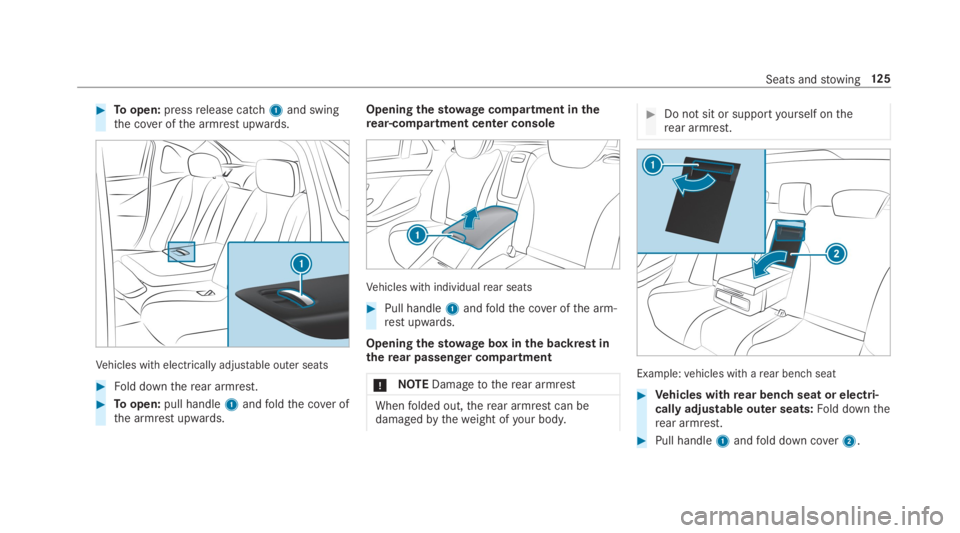
#Toopen:pressrelease catch1and swingthe cover ofthe armrest upwards.
Vehicles with electrically adjustable outer seats
#Fold downtherear armrest.
#Toopen:pull handle1andfoldthe cover ofthe armrest upwards.
Openingthestowagecompartment in therear-compartment center console
Vehicles with individualrear seats
#Pull handle1andfoldthe cover ofthe arm‐restupwards.
Openingthestowagebox inthe backrest intherear passenger compartment
*NOTEDamagetotherear armrest
Whenfolded out,therear armrest can bedamagedbytheweight ofyour body.
#Do not sit or supportyourself ontherear armrest.
Example:vehicles with arear benchseat
#Vehicles withrear benchseat or electri‐cally adjustable outer seats:Fold downtherear armrest.
#Pull handle1andfold down cover2.
Seats andstowing12 5
Page 428 of 578
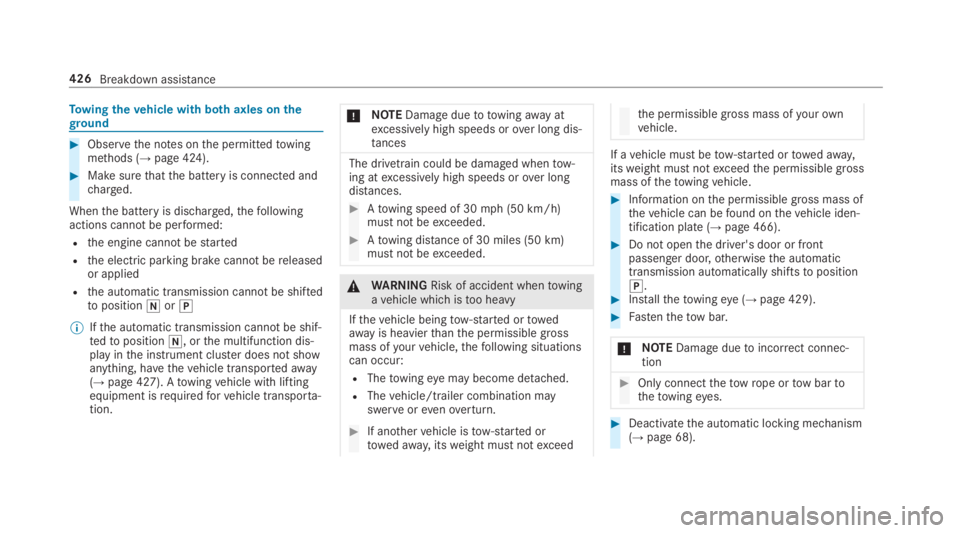
Towingthevehicle with bothaxles ontheground
#Observethe notes onthe permittedtowingmethods (→page 424).
#Make surethatthe battery is connected andcharged.
Whenthe battery is discharged,thefollowingactions cannot be performed:
Rthe engine cannotbestarted
Rthe electric parking brake cannotbereleasedor applied
Rthe automatic transmission cannotbe shiftedtoposition�\\or�]
%Ifthe automatic transmission cannotbe shif‐tedtoposition�\\, orthe multifunction dis‐play inthe instrument cluster does not showanything, havethevehicle transportedaway(→page 427). Atowingvehicle with liftingequipment isrequiredforvehicle transporta‐tion.
*NOTEDamagedueto towingawayatexcessively high speeds orover long dis‐tances
The drivetrain could be damaged whentow‐ing atexcessively high speeds orover longdistances.
#Atowing speed of 30mph (50 km/h)must not beexceeded.
#Atowing distance of 30 miles (50 km)mustnot beexceeded.
&WARNINGRisk of accident whentowingavehicle which istoo heavy
Ifthevehicle beingtow-started ortowedawayis heavierthanthe permissible grossmass ofyourvehicle,thefollowing situationscan occur:
RThetowingeye may become detached.
RThevehicle/trailer combination mayswerveorevenoverturn.
#If anothervehicle istow-started ortowedaway, itsweight must notexceed
the permissible gross mass ofyourownvehicle.
If avehicle must betow-started ortowedaway,itsweight must notexceedthe permissible grossmass ofthetowingvehicle.
#Information onthe permissible gross mass ofthevehicle can befound onthevehicle iden‐tification plate (→page 466).
#Do not openthe driver's door or frontpassenger door,otherwisethe automatictransmission automatically shiftstoposition�].#Installthetowingeye (→page 429).
#Fastenthetow bar.
*NOTEDamageduetoincorrect connec‐tion
#Only connectthetowrope ortow bartothetowingeyes.
#Deactivatethe automatic locking mechanism(→page 68).
426Breakdown assistance